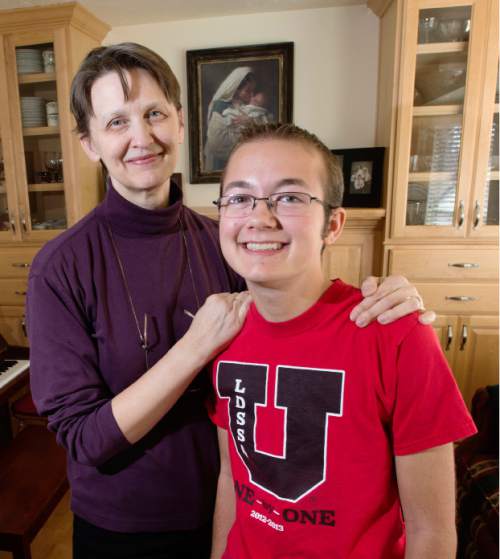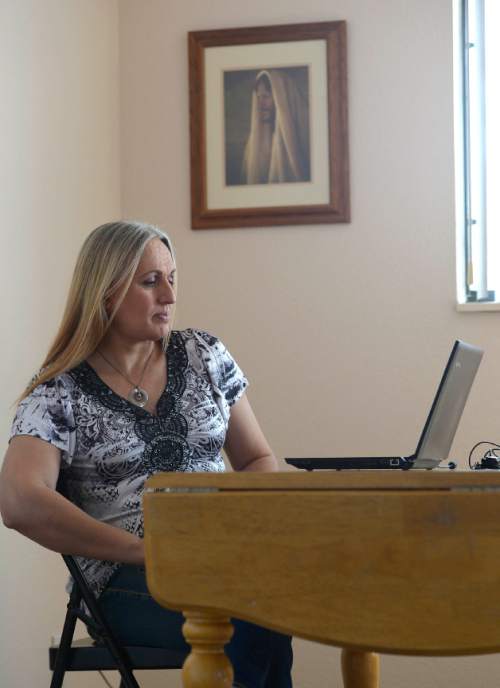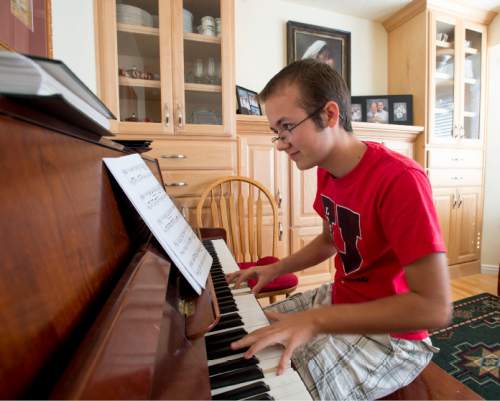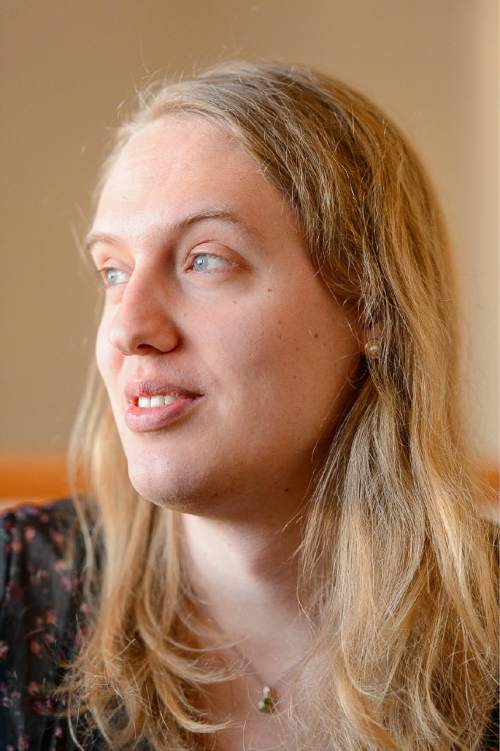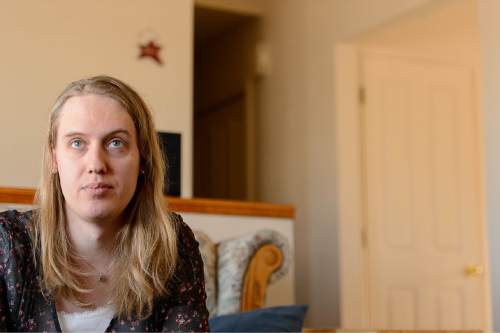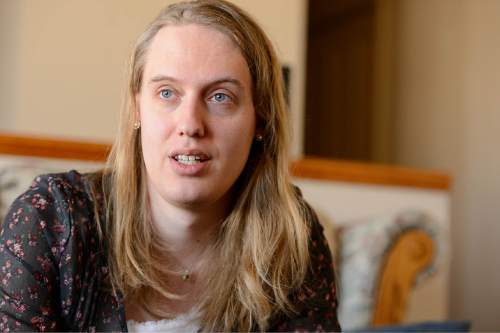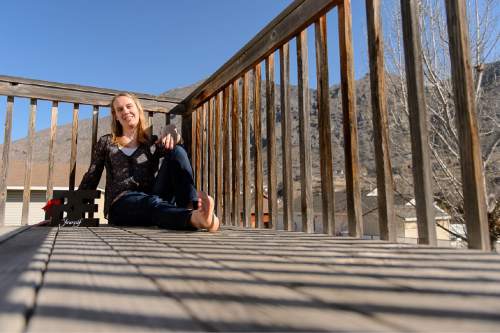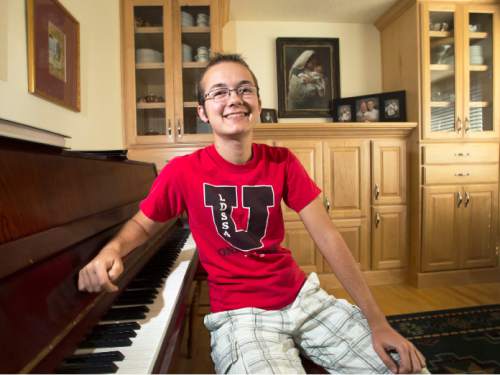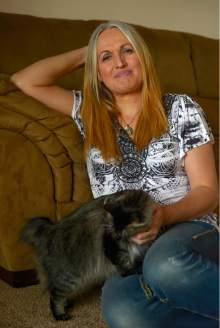This is an archived article that was published on sltrib.com in 2015, and information in the article may be outdated. It is provided only for personal research purposes and may not be reprinted.
Sixteen-year-old Grayson Moore had no label, only metaphors, to describe the disconnect he felt between his body and soul.
It was like car sickness, he says, when your eyes and inner ears disagree about whether you are moving.
"It makes you sick," Moore says. "That's the same with gender."
When Moore's mother gave her then-daughter a vocabulary for the feelings — "gender dysphoria" or transgender — there followed an immediate sense of relief and recognition.
And, he says, God confirmed that he was not just a tomboy. He was in the wrong body.
Such moments come in the life of all transgender persons — times when vague feelings of general discomfort with their identity crystallize into that realization.
Annabel Jensen was deciding whether to serve a Mormon mission. Sara Jade Woodhouse was married and had fathered a child.
In these three cases, their Mormonism — with its emphasis on the physical link between bodies and spirits and its insistence that gender is "eternal" — initially made it tougher to acknowledge what was happening inside of them.
Since switching genders (though none has had sex-reassignment surgery), all three say they have found psychological and theological peace, even divine approval, and a surprising welcome from their local LDS leaders and congregations.
They are among a growing but little understood minority in The Church of Jesus Christ of Latter-day Saints.
Transgender Mormons in Utah have formed a support group, march in gay pride parades — though most are not gay — and talk openly about their experiences. A weekly "Family Home Evening" group routinely draws about 30 participants along the Wasatch Front.
Efforts to bring awareness are crucial, they believe, because most members of the Utah-based faith know little or nothing about what it's like to be transgender. And many judge and reject transgender loved ones.
Even LDS apostle Dallin H. Oaks acknowledged recently that Mormon leaders "have not had so much experience with [transgender persons]. ... We have some unfinished business on that."
Still, the faith does have policies in place, saying elective sex-reassignment surgery "may be cause for formal church discipline," according to the church's Handbook.
In some Mormon missions, including Thailand, with its many transgender persons, missionaries ask would-be converts if they are in their "original gender."
An official LDS document, "The Family: A Proclamation to the World," written and approved by the faith's top leaders, states that "gender is an essential characteristic of individual premortal, mortal, and eternal identity and purpose."
"Because of this," church spokesman Eric Hawkins writes in an emailed statement, "the church does not baptize those who are planning transsexual operations. If a person has already had such an operation and wishes to join the church, they may be baptized only after an interview with the mission president and approval by the First Presidency.
"The church does not ordain transgender people to the priesthood or issue temple recommends to them," Hawkins adds. "Church leaders counsel already-baptized members against elective transsexual operations, and bishops may refer specific cases to the stake president for possible resolution at that level or by the First Presidency.
"We have faith that ultimately, the emotional pain that many of these people feel will be addressed by a loving God who understands each individual's circumstances and heart."
Hawkins declined to comment about the church standing and prohibitions for those who have had only hormone treatments.
Many active LDS transgender persons accept the church's statements about gender being an essential characteristic and are willing to live with some restrictions.
Still, despite how comfortable transgender Mormons are in their new skin, the LDS Church is a very gendered place — men go to priesthood meetings, women to Relief Society; men officiate at rituals and general meetings, women lead auxiliaries; men sit on one side in the temple, women, generally, on the other — and that complicates their lives inside the faith.
—
'Am I your son?' • Growing up in Davis County — or "Mormonopolis," as Moore calls it — the young Latter-day Saint girl named Grace had severe panic attacks beginning in late elementary school and continuing through junior high. By high school, says the 22-year-old math major at the University of Utah, his distress — including physical symptoms such as nausea — was so extreme he hardly could function.
Moore's mother, Neca Allgood, took him to various doctors but no one could diagnose his problems.
Trained as a molecular biologist and a scientist by instinct, Allgood had a suspicion that her daughter might have "gender dysphoria."
When Allgood asked Moore if he was a girl in his body but a boy in his brain, the young man simply said, "not just my brain — in my soul."
With that recognition, Moore's life, at last, made sense to him.
"There's a word for it," he remembers thinking, "I'm not crazy."
That night, Grace Moore knelt in prayer, asking God, "Am I your son?"
He says he got a powerful spiritual affirmation that he was, indeed, a boy and that "it was going to be OK."
His mother essentially received the same message.
"The answer to my prayers was to love him and help him live as a boy," she says. "It increased my testimony and understanding of the Holy Spirit."
Mother and son talked it over and decided he needed to transition quickly.
During six weeks of his junior year in high school, Grace became Grayson, tossed out all the girl clothes, and began identifying as male.
Allgood was supportive, but worried about her son's safety.
"There was a bigger risk in not transitioning," he says. "Living that lie was killing me."
When he prayed about whether to begin taking testosterone treatment, he says the answer was to "wait," which he did. By college, however, he says he got the divine go-ahead and has seen a change as his body has become more male.
Moore has not yet had surgery but doesn't rule it out.
He attends an LDS singles ward, where he has the full support of his Mormon bishop. He goes to the male-only priesthood meetings but hasn't been ordained — and, under current church policy, won't be.
He's still listed as a female on LDS membership rolls.
—
From fonts to altars • Moore's mother doesn't see sex-reassignment surgery as a matter of choice.
According to a poll conducted by the National Gay and Lesbian Task Force and National Center for Transgender Equality, 41 percent of transgender persons have attempted suicide.
That is dramatically more than "the 4.6 percent of the overall U.S. population who report a lifetime suicide attempt, and is also higher than the 10 percent to 20 percent of lesbian, gay and bisexual adults who report ever attempting suicide," reported the American Foundation for Suicide Prevention.
Thus, sex-reassignment surgery may seem urgent, Allgood says, rather than a simple choice.
"Gender dysphoria can be life threatening. The distress caused by the mismatch between body and spirit can lead to depression and even suicide," she says. "That says to me it is no longer elective. It is lifesaving."
When a patient goes to a doctor with a pain, the doctor doesn't say, "Prove it," she notes. "The doctor finds a way to treat the pain."
In the case of transgender patients, the pain is in their brain.
"We should believe them," she says, "and treat the pain."
Transgender persons should not be barred from joining the LDS Church, Allgood says. "Baptism and receiving the Holy Ghost are not gendered ordinances. We use the same words baptizing or confirming a boy or a girl."
Other LDS rituals — such as eternal marriage in Mormon temples — are divided by sex, she says. "I can understand why even a transgender who is worthy to attend the temple might not be given a recommend. It's not a worthiness thing — the recommend questions are the same — but because the temple ordinances are different for men and women and because we don't know enough doctrinally."
While the church awaits divine revelation on the topic, she says, policies should be welcoming and compassionate.
The church, she says, doesn't "need revelation for that."
—
A different song • During puberty, Annabel Jensen — then known as Christopher — began to feel more and more uncomfortable in male clothing and fulfilling LDS male obligations.
She wrestled with female feelings, constantly begging God in prayer to take them away. She became increasingly devout, embracing every assignment in her Roy LDS ward as she moved up the ranks of Mormonism's all-male priesthood quorums.
"I did everything I could to invoke God's help," Jensen says, "but the feelings never went away."
At 19, Jensen was ordained an elder — a precursor to serving a two-year mission — and began to confront the reality of her female gender.
Jensen knew she couldn't serve.
"I'd be asked to use my priesthood, and it wouldn't feel right," she says. "It is not something that is mine to use."
Jensen moved to Provo, started attending Utah Valley University and stopped going to church.
"It didn't have what I needed at the time," Jensen says. "Continuing to go and attending priesthood wouldn't have worked well for me."
Two years ago, she came out to her parents.
"They were shocked; they had no idea this was going on my whole life," she says. "They didn't know what to say."
They said she couldn't come home wearing a dress, nor would they use her new name or female pronouns.
"One of my brothers sent me a text calling me a monster," Jensen says. "I miss my family, but I don't want to visit. It's become too painful."
Until April 2013, Jensen thought that cross-dressing would fulfill all her needs but found that was not enough. She took a UVU choir class and wore a dress to rehearsals, but when the time came for a performance, the conductor insisted she wear a suit.
"I cried during the whole concert," she says. "At that point, I realized I couldn't pretend to be a guy any more and began looking at making a full transition."
Jensen took hormones and within weeks started to feel female. Her skin softened, breasts swelled, fat shifted, hair diminished (though she still has to shave her face).
"Everything about my body began to feel right," she says.
The positive feelings prompted her to return to her religious roots.
One Sunday, in October 2013, Jensen announced her transgender identity to a Springville LDS singles ward bishop and asked if she could attend church.
" 'I don't know anything about being a transgender Mormon,' " she recalls him saying, " 'but it's my job to welcome you..' "
The Springville experience was richer than the worship she knew during her youth, she says, because she could "be in tune with the Holy Spirit."
But Jensen was not yet ready for the LDS dating scene, so she and her roommate — also a transgender person — went to a family ward in August 2014.
Again, the local LDS leadership — both men and women — welcomed the transgender women without hesitation. The Relief Society president, a therapist with LDS Family Services, asked if they wanted to be "visiting teachers," meeting monthly with other women in their homes.
"Everyone else presumes we are women," Jensen says. "We go to Relief Society meetings and are part of the sisterhood."
It feels, she says, "fabulous."
—
Essential gender • Sara Jade Woodhouse believes the LDS family proclamation is correct: Gender is eternal.
It's just that nature sometimes matches the bodies incorrectly, Woodhouse says. "Since nature may surprise us and not follow that formula — we know that some people are born with ambiguous genitalia or with both — it is absolutely possible for a perfect feminine soul to end up in a male body and vice versa."
Woodhouse, for example, felt she was in the wrong body when children began to divide into boy and girl groups.
"I knew I didn't belong in the group I was expected to join," she recalls. "I felt way more comfortable among the girls."
But this was Salem, Utah, and being different in a small town "was not a good thing," Woodhouse says, "so I found a way to fit in."
She fought those feelings for many years, all through puberty, college, even fatherhood.
Eventually, though, she felt she needed to transition to her real self or die.
"I chose to transition."
Woodhouse told her then-wife, "This is my problem and I am going to fix it."
Next, Woodhouse told her Mormon bishop, who was sympathetic, but asked, "Why can't you be the best woman in a man's body you can be?"
She spoke with a therapist at LDS Family Services, looking for a "cure" or "solution."
The therapist told her: "You are not sick. I can't cure you. This is who you are. You are going to have to figure out what to do about it."
When Woodhouse told her then 5-year-old daughter that Daddy was going to become a woman, the child said, "That's weird," and then, "we can play with dolls when I come to visit you."
In the past, Woodhouse says, the LDS Church was not particularly accepting of transgender members, so many either left or hid.
"You can be gay or lesbian and no one will know that unless you tell them," she says, "but for [a transgender person], gender identity is so much a part of who you are that you need to portray externally so you feel comfortable when you look in the mirror."
Today, many transgender Mormons are accepted by various LDS congregations, Woodhouse says. "We will see the number of active trans grow as they feel confident enough to be themselves."
Woodhouse is not allowed to attend the women's Relief Society in her Midvale ward but hopes one day to marry a man in the temple.
As for now, she remains on church records as a man. The only way to fix that, she says, would be for her to be excommunicated.
Then, if church leaders agree, she could be rebaptized as the woman she sees as her true self.
Twitter: @religiongal Gender is 'eternal'
"All human beings — male and female — are created in the image of God. Each is a beloved spirit son or daughter of heavenly parents, and, as such, each has a divine nature and destiny. Gender is an essential characteristic of individual premortal, mortal, and eternal identity and purpose.
Source: 'The Family: A Proclamation to the World," lds.org






